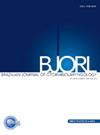Who’s afraid of Dura Mater?
IF 1.7
4区 医学
Q2 OTORHINOLARYNGOLOGY
引用次数: 0
Abstract
Objectives
To overcome the fear associated with conventional nomenclature related to different anatomic positions for Bonebridge.
Methods
Bonebridge is an active transcutaneous semi-implantable bone conduction device available for clinical use since 2012. Bonebridge is indicated in patients with conductive and mild mixed hearing loss and a bone conduction threshold above 45 dB. This situation can be mainly found in patients with aural atresia, radical cavities, chronic otitis media and selected cases of otosclerosis not suitable for stapedectomy or hearing aids. The initial proposal was to position the implant in the mastoid, adjacent to the external ear canal. This position cannot be used in patients with radical cavities and should not be used in patients with aural atresia to avoid complications of future ear reconstructive surgery. New positions were soon implemented in the retrosigmoid and the middle fossa areas. However, the terms “retrosigmoid” and “middle fossa” are clearly linked to skull base surgery and create reluctancy among a large number of potential users.
Results
To avoid the negative reaction of otologic surgeons to these names we propose the use of easy to remember names related to the anatomic location of the implant. These names have been presented to the scientific community in meetings over the last decade and are now published in this short paper.
Conclusion
The new nomenclature proposed for the different anatomic positions available for Bonebridge is designed to stop the association between Bonebridge and skull base surgery.
Level of evidence
Level 2.
求助全文
约1分钟内获得全文
求助全文
来源期刊

Brazilian Journal of Otorhinolaryngology
OTORHINOLARYNGOLOGY-
CiteScore
3.00
自引率
0.00%
发文量
205
审稿时长
4-8 weeks
期刊介绍:
Brazilian Journal of Otorhinolaryngology publishes original contributions in otolaryngology and the associated areas (cranio-maxillo-facial surgery and phoniatrics). The aim of this journal is the national and international divulgation of the scientific production interesting to the otolaryngology, as well as the discussion, in editorials, of subjects of scientific, academic and professional relevance.
The Brazilian Journal of Otorhinolaryngology is born from the Revista Brasileira de Otorrinolaringologia, of which it is the English version, created and indexed by MEDLINE in 2005. It is the official scientific publication of the Brazilian Association of Otolaryngology and Cervicofacial Surgery. Its abbreviated title is Braz J Otorhinolaryngol., which should be used in bibliographies, footnotes and bibliographical references and strips.
 求助内容:
求助内容: 应助结果提醒方式:
应助结果提醒方式:


